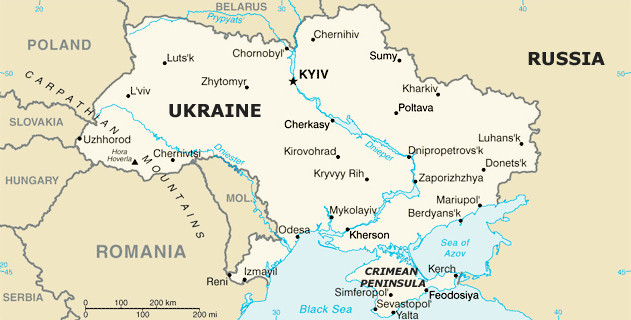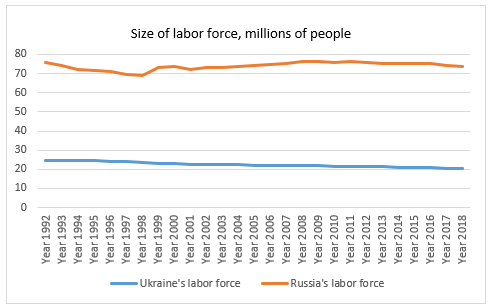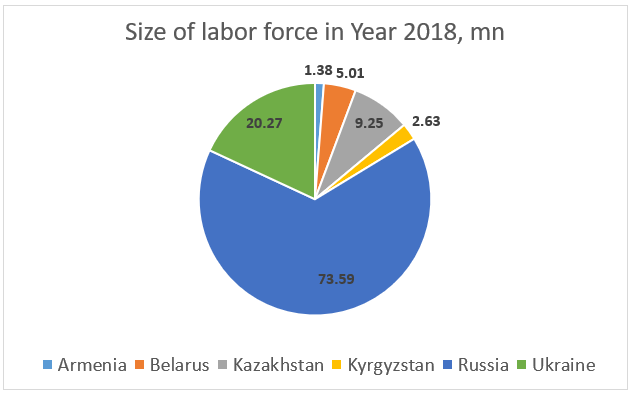Key to Putin’s Passport Offers to Ukrainians? Russia’s Shrinking Labor Force

(Russia Matters – Simon Saradzhyan – April 30, 2019 – russiamatters.org/blog/key-putins-passport-offers-ukrainians-russias-shrinking-labor-force)
 The Kremlin’s hope is that Ukraine and other CIS countries can continue to mitigate the decline of Russia’s own labor force until major social and health reforms aimed at re-stimulating births and extending longevity produce results in the longer term (if they ever do).If Putin’s plan succeeds, it may also help to stop Russia’s depopulation, which resumed last year for the first time since 2009, with declining inbound migration failing to compensate for the difference between deaths and births. It was the number of migrants from Ukraine that dropped at the greatest rate in 2018, according to the RANEPA researchers. The net number of migrants from Ukraine declined by a whopping 393 percent from 48,800 in 2017 to 9,900 in 2018.
The Kremlin’s hope is that Ukraine and other CIS countries can continue to mitigate the decline of Russia’s own labor force until major social and health reforms aimed at re-stimulating births and extending longevity produce results in the longer term (if they ever do).If Putin’s plan succeeds, it may also help to stop Russia’s depopulation, which resumed last year for the first time since 2009, with declining inbound migration failing to compensate for the difference between deaths and births. It was the number of migrants from Ukraine that dropped at the greatest rate in 2018, according to the RANEPA researchers. The net number of migrants from Ukraine declined by a whopping 393 percent from 48,800 in 2017 to 9,900 in 2018.
| Net inbound migration, in thousands | Year 2017 | Year 2018 | % change |
| International migration, including | 156.2 | 89.9 | -74% |
| All CIS Countries | 152.4 | 93.8 | -62% |
| Azerbaijan | 9.6 | 11.8 | 19% |
| Armenia | 5.7 | 5.4 | -6% |
| Belarus | 7.7 | 6 | -28% |
| Kazakhstan | 22.2 | 18.2 | -22% |
| Kyrgyzstan | 12.6 | 9.1 | -38% |
| Moldova | 6.6 | 5.3 | -25% |
| Tajikistan | 23.5 | 22.3 | -5% |
| Turkmenistan | 1.3 | 1.7 | 24% |
| Uzbekistan | 14.6 | 4.1 | -256% |
| Ukraine | 48.8 | 9.9 | -393% |
| “Far abroad” countries | 3.8 | -3.9 | -197% |
The decline in the overall number of inbound migrants is believed to have been primarily driven by the fact that the ruble has lost much of its value against the dollar and other currencies, as well as by the considerable slowdown in Russia’s economy, making the country’s labor market less attractive.
Moreover, unlike the situation prior to the 2014 revolution in Ukraine, Russia now faces much stiffer competition for Ukrainian workers with the EU. Before Viktor Yanukovych was ousted, Russian strategists had hoped they could woo his government to bring Ukraine into the Moscow-led Eurasian Economic Union. Such an addition would have boosted the union’s labor force by 22 percent. Instead, post-Yanukovych Ukraine proceeded to sign association and trade agreements with the EU, eventually making it easier for Ukrainians to travel to and work in the EU. As a result, Ukrainian nationals received more first-time residence permits in the EU in 2017 than nationals of any other country (662,000), according to Eurostat, nearly 90 percent for work; of the total, 88 percent went to live in Poland. There may now be as many as 2 million or more Ukrainian migrants living in Poland alone, with at least hundreds of thousands more residing in other EU countries, compared to about 3 million in Russia.
Ukrainians who are legally employed in the EU and able to make the bloc’s average net minimum wage of 732 euros a month may find Putin’s offer of fast-track citizenship unenticing, given that the average Russian wage as of this year was under 590 euros (42,413 rubles). However, there are also many Ukrainian nationals working in the EU illegally—including, possibly, half of the Ukrainians working in Poland, according to a Ukrainian trade union leader’s 2018 estimate. Some of these illegal workers may perhaps find Putin’s invitation more attractive, and the same can be said of millions of Ukrainians still working in Ukraine, where the average monthly wage is about 340 euros.
While Putin’s hopes of integrating Ukraine into the Eurasian Economic Union were dashed by the 2014 revolution, the Russian leadership has refused to yield in its battle with the EU over Ukraine’s shrinking labor force and Putin’s April 24 decree is the latest evidence of that determination.
| Eurasian Economic Union | Eurasian Economic Union with Ukraine | % difference | |
| Labor force, 2018, in millions | 91.9 | 112.1 | 22% |
| GDP, constant dollars, 2017, in billions | 1958.7 | 2086 | 6% |

1Percentages refer to the working-age population with an advanced level of education who are in the labor force. Advanced education includes short-cycle tertiary education, a bachelor’s degree or equivalent education level, a master’s degree or equivalent education level or a doctoral degree or equivalent education level according to the International Standard Classification of Education.
2“Labor force” comprises people aged 15 and older who supply labor, according to the World Bank.
Article also appeared at russiamatters.org/blog/key-putins-passport-offers-ukrainians-russias-shrinking-labor-force, with different images, bearing the notice: “© Russia Matters 2018 … This project has been made possible with support from Carnegie Corporation of New York,” with a footer heading entitled “Republication Guidelines” linking to: russiamatters.org/node/7406, which bears the notice, in part:
“If you would like to reprint one of these articles, a blog post written by RM staff, one of our infographics or a fact-check, we ask that you follow these guidelines:
- Include a prominent attribution to Russia Matters as the source and link back to the original at RussiaMatters.org.
- Retain the hyperlinks used in the original content.
- Do not change the meaning of the article in any way.
- Get an ok from us for non-substantive changes like partial reprints or headline rewrites and inform readers of any such modifications (e.g., This article first appeared on the Russia Matters website with the headline “Russian Election Interference in Trump’s Own Words”).
- Let us know about the reprint and send a link!
Please note that Russia Matters cannot grant permissions for third-party content, including articles, photographs and other materials not produced by our team.
Questions? Email us at RussiaMatters@hks.harvard.edu.”

